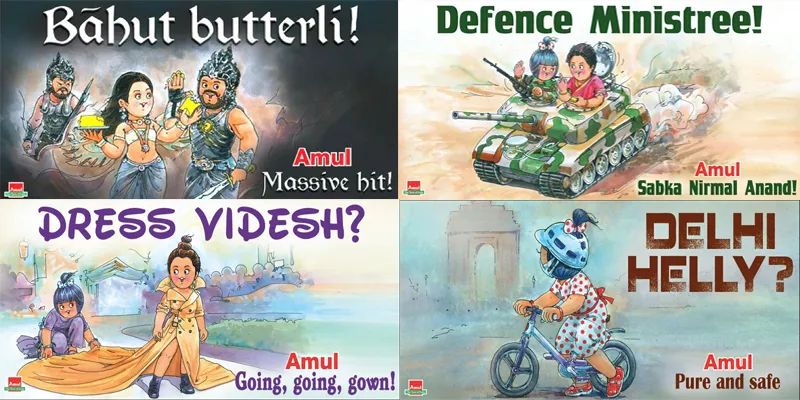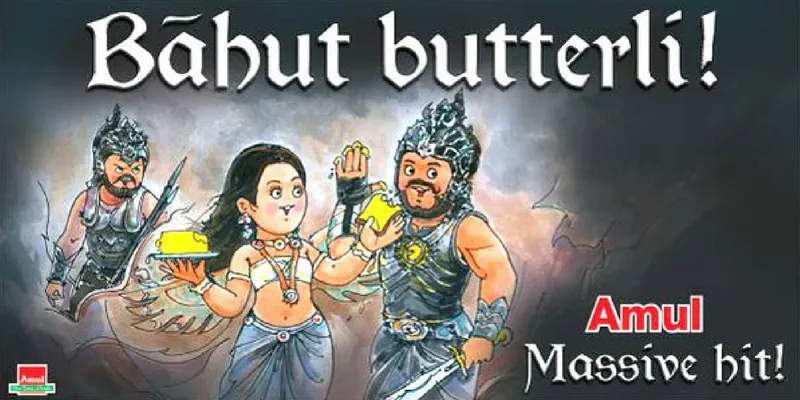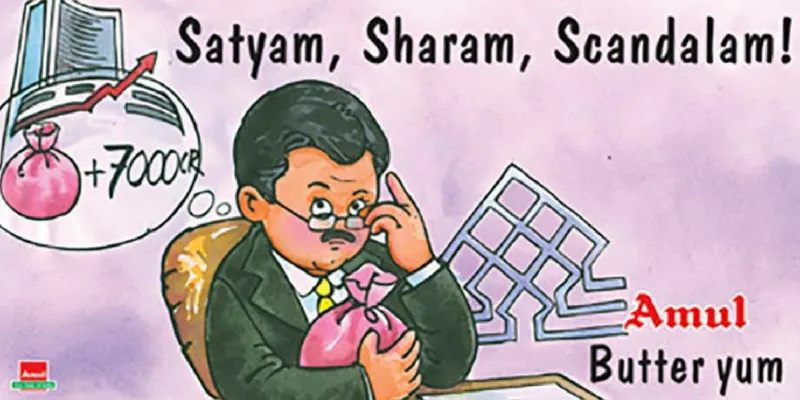The Amul campaigns continue to deliciously capture the pulse of India
For five decades now, Amul’s blue-haired girl in a polka-dotted frock has remained relevant by commenting on the most current issues and significant events with witty humour and timely punchlines.

Be it Bollywood, Olympics, politics or cricket, it wouldn’t be wrong to say one can stay up to date with current affairs with the Amul girl.
The longest-running ad campaign in India was conceived by noted ad man Sylvester daCunha in 1966 and is now run by his son, Rahul daCunha.
There is always a concern for a campaign that runs that long— whether it will still have resonance and relevance for a younger audience, Rahul says.
But Amul has not just stood the test of time, but, it has aged rather deliciously.
Advertisement for all ages
The Amul girl’s wit and satire managed to capture the imagination of every Indian, irrespective of region, language, gender or age. During the outdoor campaign days in 1960s and 70s, the hoardings were hand-painted on billboards and the Amul girl was a little chubby.

Back then, daCunha Communications created one topical a month; today, they have five ad campaigns a week. They are present in billboards and outdoor media, print advertisements, and social media.
An issue that was relevant for a month to 45 days in the 70s is no longer relevant for that time span now. The team meets on Monday and we decide the different topicals for that week, Rahul says.
From topic finalisation to headline, the three-member team completes an ad campaign within a few hours. However, ideation remains a 24/7 exercise.

Given the vast canvas of events that occur daily in different parts of the country, Amul campaigns run targeted advertisements depending on demographics.
The team has divided India into five divisions— an exclusive campaign designed for Mumbai city with 25 outdoor media sights; the Hindi belt comprising North Indian states, Southern India, the East comprising West Bengal and the North-Eastern states, and social media.
The beginning
It all began when Sylvester daCunha and his art director Eustace Fernandez wanted to create an advertisement campaign that appealed to mothers and children as Amul’s main target audience. There was no television in the 60s and advertising was limited to either expensive print— newspaper and magazines — or outdoor billboards.

With his idea centred on a little girl in polka-dotted red dress, blue hair and the tag line “Utterly Butterly Delicious”, Sylvester met Dr Kurien, the father of the White Revolution of India.
Dr Kurien said, ‘Look, if you people think it will work, fine; but I don’t understand how a girl with polka dots making a statement about odd things is ever going to sell butter, Rahul recalls.
Yet, he had faith in Sylvester’s vision. Initially the daCunha Communications team was engaged in advertisements that spoke just about “butter” on a hand-painted outdoor hoarding. In a year, they realised that they had hit a dead end.
“After all, there is only so much that you can talk about butter,” Rahul says.

And this marked the beginning of the team’s experiment with “topical hoardings,” which aimed at giving people food for thought. While making the switch, to using a witty one-liner to connect current affairs topic to butter, Sylvester requested Dr Kurien to give the creative team “complete freedom”. This freedom fuelled Amul’s new journey.
“He told the client is the only way this will work is if we have full freedom to create this campaign. If we try to send you the ad, wait for your approval— it will not work,” Rahul remembers.
Dr Kurien agreed. He said, ‘Look if there are problems, you need to deal with it. If you are arrested, then you are arrested. We are not going to bail you out of jail.’ To this day, 50 years later, they give us this freedom to run our ad campaign.

In March 1966, Amul ran its first topical advertisement capturing the first derby match in Mumbai.
Buttering the controversies
If you have noticed, over the years the girl has played numerous roles depending on the issue— she is a cheerleader, celebrator, a crusader, conscience, commentator, scenic— but she is never malicious, Rahul says.
Perhaps this is the primary reason political parties are not “bothered” about the Amul advertisement campaign, which has often features political stalwarts like Lalu Prasad Yadav, Mamata Banerjee, Kumari Mayawati, Mulayam Singh Yadav, Manmohan Singh, Narendra Modi, among several others.

When Akhilesh Yadav, former Chief Minister of Uttar Pradesh campaigned in 2012 Uttar Pradesh elections, Amul ran an advertisement campaign with sentences, “Samajworthy Party?” Rahul says, “Akhilesh loved it; he cut it out and put it on his notice board.”
Daring days
However, Amul has faced its share of controversies and the company ran into legal problems for advertisements involving Jagmohan Dalmiya, Suresh Kalmadi, Satyam Computers and Subrata Roy.

In 1998, when Jagmohan Dalmiya was at the height of his power and Rahul was younger, he says he was “a little more daring”.
Their billboard then said, ‘Dalmiya mein kuch kaala hai’ on top and 'Amul: Maska khao, paisa nahin’ at the bottom. In response, Dalmiya threatened to sue Dr Kurien for Rs 500 crore and sent him a court notice instead of to daCunha Communications.

Dr Kurien called Rahul; he explained to him that the ad had depicted Dalmiya in the famous three monkey caricature “See no evil, hear no evil, speak no evil” pose.
Rahul recalls:
In response, Dr Kurien recommended another hoarding - two hands covering the eyes, the ears, the mouth and add a fourth, with his hands covering his private parts. So that was Dr Kurien. Times are different now, but there was a time when we did some crazy things.
Amul is India
Yet despite the few contentious ads, the Golden Girl continues to rule hearts in India.
We have never taken sides; we comment on the issue, never the people. Amul is a reflection of what the larger population is thinking and feeling about an event.

When India conducted a surgical strike, Amul did not respond with an ad immediately. They waited to see public response, following which an ad saluting the armed forces came out.
At any given point there are different topicals across the country. In a sense, Amul reflects what India is going through and what India is going through reflects on Amul. Some facts, some fiction, Rahul says.
Beyond being a brand
Rahul doesn’t believe that mere advertising can create a better society. The role of ads is to inform people and consumers about brands.
If they help to make a better society, that's a bonus, he says.

Today, Amul is not just a brand; it is a movement that represents public emotions. The chubby-cheeked Amul girl continues to speak her mind fearlessly, speaking for all of India.







